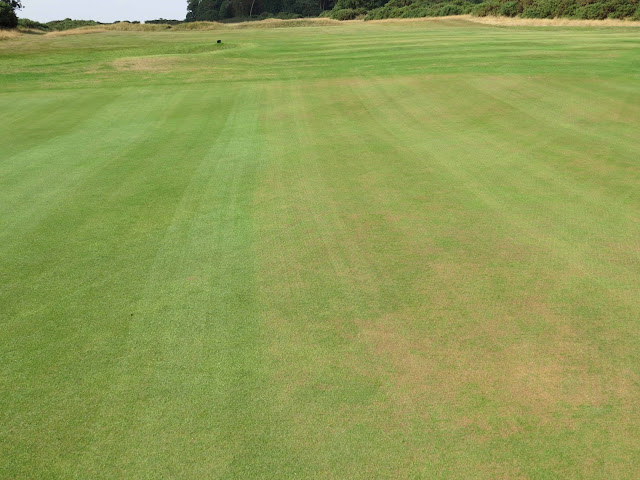In
early September we over-seeded the greens with high quality cultivars of fescue
and bent grass. Our aim is to increase
the percentage of these grasses in our greens as they are capable of producing
a much finer and denser putting surface than older cultivars. The new 3rd green on the river
course is a good example of what we’re striving for, as it was constructed with
100% fescue turf. After over-seeding the
greens required regular irrigation to enable the seed to germinate and to keep
the new seedlings alive. As a
consequence of increased irrigation and other work such as top dressing to
restore surface levels after the over-seeding the greens were much slower for
the first couple of weeks of September and this dropped the average for the
month to 8ft 1in - quite a contrast with the 10ft 9in average for August. Once the new seed established, irrigation was
stopped and the green speed increased to 9ft as they dried out. Todays speed (6th Oct) is 9ft 8in
and as it’s windy we’ve used a plastic tunnel to get more accurate
readings. Wind has a net slowing effect
on stimpmeter readings even though the reading is an average of two rolls in
opposite directions. This was well
illustrated today as on the exposed 14th there was a 10in difference
in the speed with and without wind protection but on the sheltered 18th
there was no difference.
A
selective weed-killer (Rescue) that knocks out coarse Ryegrass and Yorkshire
Fog in turf was applied to the immediate green surrounds and a few metres of
the approach to the greens. Coarse grass
in these areas has been a long standing issue and we’re committed to improving
this area of weakness. The impact on the
coarse grasses has been good and although many areas look patchy at present,
they have been over-seeded and new finer grasses should fill in the gaps. Getting
rid of the coarse grass completely will probably take several years but
in subsequent years the impact will not be as great as for this first
application.
We’ve
also undertaken another trial of using Rescue on the main course greens. Theoretically this should be an excellent
product for us, enabling us to bring about significant improvements to the
greens by removing the coarser grasses.
Unfortunately, in practice things are a little more difficult. Rescue can also have a strong negative impact
on Highland bent, an old grass cultivar that makes up a significant percentage
of our greens. Although our greens would
be improved in the long term by replacing Highland bent with modern cultivars
the negative impact on the greens by removing it in one go would be
considerable. For this trial we’ve given
the greens a little more fertiliser and water than normal, as other golf clubs have
found that this reduces the impact on Highland.
It’s too early to tell how successful this has been but the early signs
are good.
Course
maintenance highlights during September
o
The greens over-seeding was very
successful with very obvious lines of new seedlings coming through.
o
The first couple of weeks after
seeding were very dry so regular irrigation was needed to encourage germination
and keep the new seedlings alive.
o
The greens were top dressed twice,
first immediately after seeding and then two weeks later
o
Topping up bunkers with sand continued
o
Rescue was sprayed on green surrounds
and approaches to remove coarse grass
o
Rescue was applied to the river course
greens, the 7th green on the main course and parts of the 8th
and 11th greens.
o
Bracken spraying with Asulox continued
o
Gorse and bramble in the rough was
sprayed with selective weed-killer.
Work
programme for October
Renovation
work to the areas of green surrounds and approaches treated with Rescue will
include hollow coring, over-seeding and top dressing towards the end of the month. Selective weed killer will be applied to some
of the fairways, and work will continue on spraying encroaching gorse and
bramble.
The
final top dressing of the greens this year is scheduled for the week beginning
the 24th October.
The
programme of regular aeration work will start and this will continue throughout
the winter and spring. This aeration
using deep tines alternating with shallower but more closely spaced tines is
vital to combat the compaction caused by players and machinery.
Our
winter work programme will commence at the end of the month. This winter rebuilding the 1st and 8th tees
and levelling the 6th tee are the main priorities, together with the
replacement of sprinklers on 2 or 3 holes.
We are also extending the irrigation system on the 2nd and 14th fairways
to reflect the current playing lines and alongside the putting green/club house
to improve conditions in this heavily trafficked area.
STRI
Inspection
The
Clubs agronomist are due to carry out their annual visit to the course on 18th
October. This provides us with excellent
impartial feedback on the condition of the course versus their huge database of
courses across the UK including the Open Championship venues. They also provide invaluable advice in
connection with the ongoing maintenance and improvement regimes. Their report will be available in the Club
House and on the web site in due course.
















































